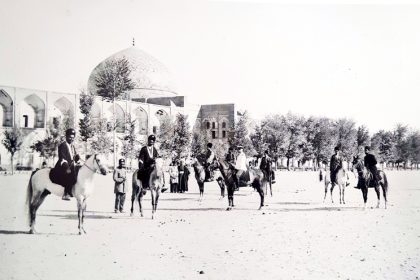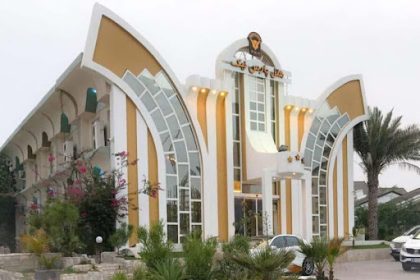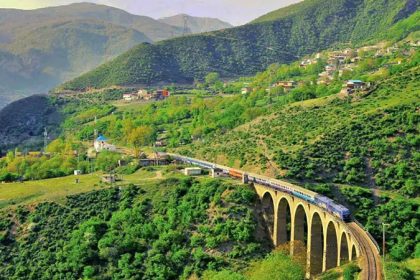Qatar has natural, historical, cultural and modern wonders that attract tourists from all over the world.
The wonders of Qatar can be divided into different fields; From the wonders including the unusual petroglyphs of Al-Jasasieh and the singing sand dunes to the historical wonders such as the victory fortress of Al-Awjaba against the Ottoman army or Souq Waqif, which has been active for more than a century. In the past few decades, Qatar has attracted huge foreign investments and has been able to add modern architectural wonders to its list of wonders, among which is the Spire Tower with an unusual hyperbolic shape. In this article, you will get to know 28 of the wonders of Qatar.
Wonders of Qatar:
Al Shaqab; Arabian horse center
Al Shaqab horse breeding center is an attractive place for lovers of animals and horse racing. This center was opened by Khalifa Bin Hamad Al Thani, the former Emir of Qatar, in 1992. Khalifa’s intention to build Al Shaqab was to create a tradition in Qatar through which the heritage of the Arabian horse in Qatar would be preserved and flourished and support the breeding of this special breed of horses.
Photo Source: Explore Qatar, Photographer: Unknown
Today, Al-Shaqab is located in an area of Qatar with the same name, on a land area of 980,000 square meters, and with a unique design in the shape of a horseshoe, it has become an extraordinary and well-equipped center, and it is known throughout the world as a symbolic destination for horse riding in Qatar. There are the best facilities for breeding, raising and keeping greyhound horses in this center.
In 2023, for the first time, the World Horse Racing Championship was held outside of France and hosted by Qatar
Arabian horses have played a prominent role in the daily life of Qatari residents since ancient times and are considered a part of Qatari culture. Primitive tribes raised these powerful horses and used them in their nomadic lives; For this reason, horse riding has always been considered important in Qatar. There are different breeds of greyhounds; But in general, they can be recognized by their long and narrow necks, distinctive head and tail shape. Arabian horses are very fast and intelligent, and for this reason, they are considered a good choice for horse racing.
Al Shaqab Center has the best facilities in the world for training and caring for Arabian horses. In 2023, for the first time, the World Equestrian Championships were held outside France and hosted by Qatar. Al Shaqab Center played an important role in this hosting. This hosting was so successful that the 2025 tournament was also given to Qatar.

Photo Source: Visit Qatar, Photographer: Unknown
Qatari food and coffee; The level of hospitality of Qataris
The Qatari peninsula has often been poor throughout its history; Therefore, over time, the Qatari food style was formed in such a way that they eat only one heavy meal a day. Qatar’s continuous trade relationship with India led to the addition of special spices and flavorings to their food. The national food of Qatar is called “Machboos” or “Majboos”. Makboos is a rice dish with meat and Indian spices.

Photo Source: Feed Your Sole, Photographer: Unknown
Arabic and hot Qatari coffees are also part of their culture. The Qatari coffee ceremony itself is considered a tool for reception and communication between the host and the guests. The number of times the host fills the guests’ cups with coffee actually indicates how welcoming the host is. Qataris are renowned hosts and treat their guests warmly and generously.

Photo Source: Daily Sabah, Photographer: Unknown
Al-Thamamah Stadium; A stadium in the shape of Arab men’s hats
“Al Thumama” is a football stadium about 13 kilometers south of Doha city center. Al-Thamamah Stadium was built to host the 2022 FIFA World Cup. The design of this stadium was inspired by the woven hats of Arab men. After the 2022 World Cup, the seating capacity of the stadium was reduced from 40,000 to 20,000. The removed seats were donated to countries that needed to improve their sports infrastructure.

Photo Source: Stadium Database, Photographer: Unknown
Qatar pearls; A man-made island with a Mediterranean atmosphere
“The Pearl Island” is an artificial island near the coast of Doha. This man-made island has an area of about 4,000,000 square meters and brings tourists a luxurious experience away from the hustle and bustle of the city. In the pearl of Qatar, there are all kinds of hotels, restaurants, cafes and shops, and its beach resort is also very symbolic and famous; Therefore, the Pearl of Doha is a popular place to visit as well as to live.

Photo Source: The Pearl Qatar, Photographer: Unknown
The wonderful pearl island of Qatar is divided into three parts: “Qanat Quartier”, “Porto Arabia” and the central part, each of which has its own style and image. Qanat neighborhood is a beautiful area inspired by the city of Venice, Italy. In this neighborhood, there are colorful buildings, beautiful and artistic bridges and canals. Tourists can spend hours exploring its stylish streets and sitting in its cafes.
The Qanat neighborhood of Pearl Island, Qatar, was inspired by the city of Venice, Italy
The Arabian Pearl Harbor of Qatar has a different style and is influenced by the modern Mediterranean model. In Port Arab, there are luxury yachts, amazing restaurants and tempting street food. The central part of the Pearl of Qatar is completely family-owned; In this section, there are large squares, vast gardens, areas for children to play and many dining options. There are a variety of French, Italian and Japanese restaurants and international cuisine in this section.
Tourists can spend a lot of time in Pearl of Qatar and have fun. Various facilities for recreation and water sports are available in this artificial island.

Photo credit: Sumfinity, photographer: Nico Trinkhaus
Al-Zubarah; The largest historical site in Qatar
In the 18th and 19th centuries, “Al Zubarah” was an important commercial, political, cultural and fishing center on the coast of the Persian Gulf. This historic site is a UNESCO World Heritage Site and takes tourists to the heart of the region’s history. Al Zabareh is located in a coastal area and about 100 km from Doha. The historical area of Al-Zubarah is 2.5 kilometers long and three important areas are located in it; The ancient ruins of Al-Zubarah, “Qal’at Murair” and Al-Zabarah Fortress.

Photo Source: Visit Qatar, Photographer: Unknown
Al-Zubarah site was built in the middle of the 18th century and quickly became the largest and most important settlement in the Qatar peninsula. This area caught fire in 1811 and never regained its former importance. In the early 20th century, the area of Al-Zabareh was completely abandoned and became its current form. The whole area includes the ruins of large fortifications, houses, mosques, a market and a grove of 60 hectares. Today, Al-Zabare area has a service center and a center for tourists to tell the history of the people who once lived here.
In the middle of the 18th century, Al-Zubarah became the largest and most important settlement in the Qatar Peninsula.
Al-Zabarah Fort was built in 1938 by the order of Sheikh Abdullah bin Jassim Al-Thani to strengthen the northwest coast of Qatar. This fort is an example of many fortifications that were built to control the sea and water resources of the region. In terms of architecture, Al Zabareh Fort is a good example of the combination of Arabic and Gulf styles.
Merir Castle is located near Al-Zabare Fortress, which was considered a local settlement. In Merir Castle, there were several houses, wells, reservoirs and mosques. Today, only one well can be seen; However, archaeological excavations are still ongoing. One of the most important functions of Al-Zubarah is to create another way for cultural tourism in Qatar.

Photo source: bucharest.embassy.qa, photographer: unknown
Elbit Stadium; A stadium similar to the tents of Arab tribes
Al-Bayt Stadium is a stadium with a retractable roof in the coastal city of Al Khor, Qatar, 50 kilometers from Doha. This stadium was opened to host the 2022 World Cup. The canopy of Al-Bait Stadium is inspired by the traditional tents of Arab nomads. Elbit is one of the biggest stadiums in Qatar with a capacity of 60,000 people. The seats in the upper part of this stadium can also be dismantled and sent to developing countries.

Photo source: qsl.qa, photographer: unknown
Raffles Doha Hotel; A super luxury experience in the heart of Qatar
Raffles Hotel Doha is located in Katara Towers in Doha, Qatar, where there are suites with sea and city views. Raffles guests stay in amazing rooms with numerous amenities and get the best experience of traveling to Doha.

Photo Source: Raffles Hotels, Photographer: Unknown
Raffles Doha Hotel is one of the most luxurious hotels in Doha. The guests of this hotel will experience the best possible hospitality and accommodation. Raffles luxury rooms redefine the concept of luxury with their exquisite style. The rooms and suites are designed with the art of “feng-shui” arrangement to create maximum comfort for the guests.
The atmosphere of Raffles rooms changes at different times of the day and occasions. Facilities such as massage and even food menus are different according to the age and wishes of the guests. “Katara Hall” in Raffles Hotel, with an area of 3,800 square meters, is the largest and most luxurious space in Doha for holding ceremonies. This hall has an arched ceiling with a height of 21 meters and a terrace with a sea view.

Photo Source: Raffles Hotels, Photographer: Unknown
Petroglyphs of Al-Jasasiyya; From Egyptian rock art
“Al Jassasiya” is an area with old petroglyphs, ruined residences and pottery remains from the 15th century onwards, located in the city of “Al-Shamal” (Madinat ash Shamal) in the northeast of Qatar. In Jabal Al Jassiyah, about 900 unusual petroglyphs can be seen in more than 580 sites, most of which have geometric patterns, animal designs, and boats; But in some places, holes have been created on the stone around a bigger hole that was probably once used for playing.

Photo Source: Visit Qatar, Photographer: Unknown
The petroglyphs of Al-Jasasiyya were probably created in the 18th and 19th centuries. This site, which was discovered in 1957, displays the largest rock art in Qatar. These petroglyphs are similar to the rock art of Karnak Temple in Egypt. Al Jassia is one of the most important tourist destinations in Qatar.
Spire Tower; A hyperbolic skyscraper with a big torch
Aspire Tower in Qatar is a 51-story skyscraper with a height of 300 meters, which has an unusual hyperbolic shape. This skyscraper is also known as Torch Tower and in 2006, it was the focal point of the 15th Asian Games. At that time, a large torch was placed on the tower. The Spire Tower is the second tallest structure in Qatar and Doha and is currently used as a hotel. The lighting technology of the tower has colored LEDs that create different light effects and extraordinary combinations on the building with separate programming.

Photo Source: BESIX Watpac, Photographer: Unknown
Doha Museum of Islamic Art; A museum on the water
The Doha Museum of Islamic Art is located at the end of the Corniche promenade. The museum building has a unique architecture that was built in 2008 on water with an area of over 45,000 square meters. Among the Arab countries of the Persian Gulf, this was the first museum of Islamic arts of this size. The ablution hall of the “Ahmad Ibn Tulun” mosque in Egypt has been a source of inspiration for the design of the Doha Museum of Islamic Art.
Traditional Islamic patterns (dome, geometric designs, arches, fountains) are combined with modern architecture to create the unique Doha Museum of Islamic Art. In this museum, a huge collection of Islamic arts has been collected. Qatar Museum of Islamic Art has one of the most complete collections of Islamic works. In November 2022, the Doha Museum of Islamic Art was recognized as the first zero-carbon museum in West Asia.

Photo source: WT Journal, photographer: Will Tan
Barzan Towers; Old observation towers with modern equipment
Barzan towers are located in the village of Umm Salal Mohammed, about 20 kilometers north of Doha. These towers are actually observation towers that were built at the end of the 19th century. In 1910, Sheikh Muhammad bin Jassim al-Thani rebuilt them. These towers are among the fortifications that were built to protect water resources. Barzan towers are 16 meters high and were renovated in 2003. Although the Burzan towers have a traditional Qatari design, they are equipped with an air conditioning system, a room between the towers to host guests, and a four-layer roof.

Photo source: Wikimedia, photographer: Ziad Hunesh
Al-Awjaba Castle; The winner of the war with the Ottomans
Al Wajba Castle in Al Wajba neighborhood in Al Rayyan is one of the oldest castles in Qatar. This important fortification was built in the late 18th century to the early 19th century and was renovated in 1882. Al-Awjaba is located 15 kilometers west of Doha. Al-Awjaba Castle can be considered the origin of the country of Qatar; Because during the period of Sheikh Jassim bin Muhammad Al-Thani in 1893 AD, this fort was able to stand against the Ottoman army and defeat it, and it was the beginning of the formation of the Qatari government. Four watchtowers are the most prominent part of the castle.

Photo Source: myholidays.com, Photographer: Unknown
East-West/West-East; A science fiction scene in the heart of the desert
“East-West/West-East” are a group of unusual sculptures in the middle of the desert. Four steel columns with a height of more than 14 meters are located in a row in a row one kilometer long in the east-west direction, which looks more like a scene from a science-fiction movie. This work of art was created by “Richard Serra” in 2014. Since then, East-West/West-East has become one of the famous sights of Qatar.

Photo Source: Tripadvisor, Photographer: Unknown
Alkot Castle; A fortress-museum in the heart of Doha
“Al Koot” or Doha Castle is a historical military fortress in the heart of Doha. This fort was built by Sheikh Abdullah Bin Qasim Al Thani in 1927. Elkot Castle has been converted into a museum today. Traditional Qatari handicrafts, products and photos of the daily life of Qataris are kept in this fort. Exhibitions and works of art such as plaster stone and wood decorations, boats and fishing equipment, historical photographs and oil paintings of handicraft workers have been displayed in Elkot.

Photo Source: Flickr, Photographer: CamelKW
Al-Wayzah; A ruined city with Portuguese elements
Ruwayda is a ruined city in northern Qatar that includes the remains of a residence, a large fort, a cemetery, and numerous fish traps on the beach. Wiranshahr al-Ruwaizah is located along the coast in a 2.5 km long area and is one of the largest historical areas in Qatar. This city was inhabited during the 17th and 18th centuries; But it was abandoned in the early 19th century. Al Ruwaizah Castle is considered the biggest castle in Qatar and has a Portuguese architectural style.

Photo source: I Love Qatar, photographer: pswda
Qatar National Museum; A museum similar to desert rose crystals
The National Museum of Qatar is located in an area of about 40,000 square meters and near the main palace of Sheikh Abdullah Bin Jassim Al Thani. The new building of the National Museum of Qatar was opened in 2019 and replaced the previous building that started working in 1975. The Qatar National Museum building has a unique architecture. The design of the museum building was inspired by natural crystals known as “desert rose” and intertwined plates were used in its construction. The National Museum of Qatar is divided into three chapters: the beginning, life in Qatar and the modern history of this country.

Photo Source: Werner Sobek, Photographer: Unknown
Qatar National Library; A diamond-shaped library with ancient documents
Qatar National Library is a non-profit organization that was established in 2012. The exterior of the library is diamond-shaped, which allows light to enter the large space inside the library. This library has three functions; The National Library, a research library for academic purposes and a central library suitable for the digital age. More than 1,000,000 books are kept in Qatar National Library. Books are well categorized and easily accessible. The Heritage Library in the basement of the National Library of Qatar contains documents, some of which date back to the 7th century AD.

Photo Source: Archello, Photographer: Delfino Sisto Legnani
Four Seasons Hotel Doha; It has the largest Japanese restaurant in the world
“Four Season Hotel” in Doha is a five-star luxury hotel on the Corniche beach. In this hotel, Arabic elegance and details are combined with modern comforts. Along the private marina of the Four Seasons Hotel, there is the largest Nobu restaurant branch in the world. Nobu has a combination of Japanese minimal tradition with modern luxury atmosphere. The egg-shaped restaurant Nobu has three floors and offers the best Japanese cuisine with a breathtaking view of the Doha city skyline.

Photo source: Wikimedia, photographer: Ahmad Dalloul
Qatar National Convention Center; A building standing on the branches of a cedar tree
Qatar National Convention Center was opened in 2011. In the design of the convention center building, intertwined cedar trees have kept the outer space of the structure. The branches of the trees cast a large shadow, which traditionally symbolizes knowledge. This convention center has 3,500 square meters of solar panels that provide about 12.5% of the center’s energy needs. The Qatar National Convention Center has an exhibition hall, conference hall, meeting rooms and exhibition space, and many events are held there.

Photo source: qncc.qa, photographer: gerryoleary
Al Sadra Medical and Research Center; Center with long sails
“Sidra” center is a hospital with 400 beds for women and children. The building of this center was made of steel, glass and white ceramic tiles. The architect of Al Sidra Center is Cesar Pelli, who has the architecture of the World Trade Center in New York, the Petronas Towers in Malaysia and the International Finance Center in Hong Kong. Three long sails are designed in the Al-Sadrah building, which reminds of Qatar’s seafaring culture. Inside Al-Sadreh center, there are peaceful green gardens with a water feature and suitable lighting for optimal treatment of patients.

Photo Credit: Pelli Clarke & Partners, Photographer: Jeff Goldberg
Qatar Faculty of Islamic Studies; A building with a spiral design
Education City Mosque won the architecture festival in 2015 in the religious architecture section. The mosque is based on five big pillars that represent the five pillars of Islam. This mosque is located in the campus of Qatar Islamic Studies Faculty. In the Faculty of Islamic Studies in Qatar, Islamic generalities are taught. The faculty building has a spiral design and is connected to the mosque in different ways; It means that all knowledge ultimately originates from faith.

Photo Source: Mangera Yvars Architects, Photographer: Unknown
Al-Janoob Stadium; A stadium in the shape of a shell
Al-Janoob Stadium was previously known as “Al-Wakrah” Stadium. This stadium has a retractable roof stadium that was opened in 2019. Al-Janoob was one of the stadiums that hosted the 2022 FIFA World Cup. Shells and traditional Qatari wooden floats with wooden sails were the source of inspiration for the design of this stadium. The curved design of Al-Janoob Stadium contains elements of postmodernism and “neo-futurism”.

Photo Source: Visit Qatar, Photographer: Unknown
Qatar State Mosque; A mosque with 93 domes
Qatar State Mosque, also known as Qatar National Mosque, is the largest mosque in Qatar with a capacity of 30,000 people. This mosque has a total of 93 domes, of which 28 large domes are located above the central courtyard and 65 domes are located on its external walls. While preserving the traditional aspects, this mosque also has modern elements in it.

Photo source: Time Out Doha, photographer: Alexey Sergeev
Katara Amphitheater; Greek amphitheater with Islamic elements
Katara Amphitheater was built in 2008 on a land of 3,275 square kilometers. This amphitheater is inspired by the concept of traditional Greek theater; But it is combined with elements of Islamic architecture. Katara Amphitheater with a capacity of 5,000 people is located in Katara Cultural Village. In addition to the amphitheater, an opera house, cinema, multi-purpose conference hall, Katara Beach and a market are located in the Katara Cultural Village.

Photo credit: Sumfinity, photographer: Nico Trinkhaus
Singing dunes
Singing dunes are dunes that produce a whistle-like sound. This sound is caused by the wind blowing among the sand dunes outside of Doha. To produce sound, certain conditions are necessary:
- The sand grains should be between 0.1 and 0.5 mm in diameter.
- The sand must contain silica.
- The humidity of the sand should be at a certain level.
The sand dunes around Doha have exactly these conditions that make them produce a whistle-like sound.

Photo Source: Rehlat, Photographer: Unknown
Sufficient; A market with more than a century of history
“Souq Waqif” is more than 100 years old, one of the most famous traditional markets of Doha and Qatar, which is historically important. Since its establishment, this market was used for commercial activities and was of great importance to the local people. In Souq Waqif, traditional clothes, cloth, Arabic spices, perfumes, handicrafts and Qatari souvenirs, as well as birds and pets are sold in Souq Waqif. The sale arrives. The main building of the bazaar was built in the late 19th century in the style of Qatari architecture. There are several restaurants and coffee houses in Souq Waqif. This market is still one of the important tourist destinations of Doha.

Photo Source: Bookingqube, Photographer: Unknown
Doha cityscape; Maximum diversity in architecture
The city of Doha has gathered a collection of unique buildings in one place; Buildings that dazzle the eyes one after another with attractive architectural features. As the capital and largest city of Qatar, Doha has created extraordinary and surprising cityscapes by combining traditional Qatari elements and the most up-to-date modern designs and houses 60% of the country’s population.

Photo Source: Pinterest, Photographer: Sanjiban2011
Sheikh Faisal Bin Qasim Al Thani Museum; A museum with thousands of works
Sheikh Faisal Bin Qasim Al Thani Museum is a private museum in Al-Shahaniya, Qatar. This museum includes five halls and objects that Sheikh Faisal Bin Qasim Al Thani collected from the early 1960s onwards. Sheikh Faisal built the museum in 1998, in an area of 530,000 square meters and in three buildings. More than 30,000 exhibits, including rare wildlife, old cars and exquisite carpets, are kept in the Sheikh Faisal Museum. Tourists of all nationalities can visit this museum.

Photo Source: Expedia, Photographer: Unknown
If you have visited the wonders of Qatar, share your experience with us and other travelers.
Cover photo: Pearl of Qatar; Cover photo source: Qatar Day, photographer: unknown
Frequently asked questions
What are the wonders of Qatar?
Some of the wonders of Qatar include the East-West/West-East Columns, Singing Sand Dunes, Al-Awjaba Fort, Al-Thamamah Stadium, Spire Tower, Souq Waqif, Qatar Artificial Island and Al Ruwaizah Ruins.
What is the reason for the sound of the singing dunes?
Singing dunes are dunes that produce a whistle-like sound. This sound is caused by the wind blowing among the sand dunes outside of Doha.
RCO NEWS


















